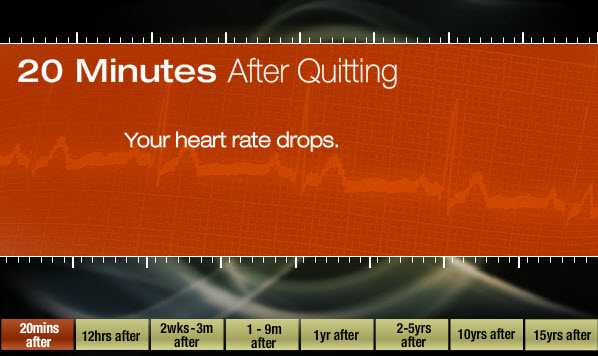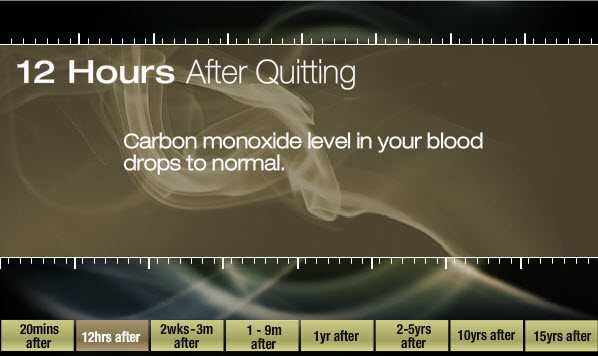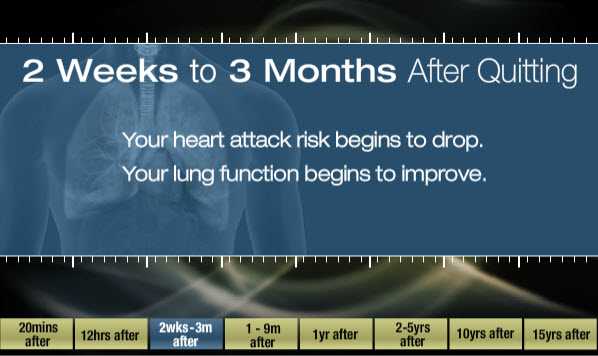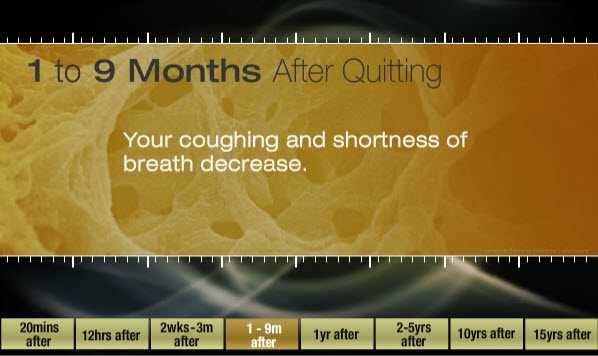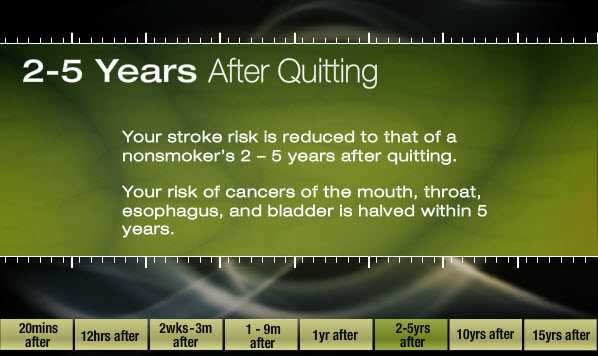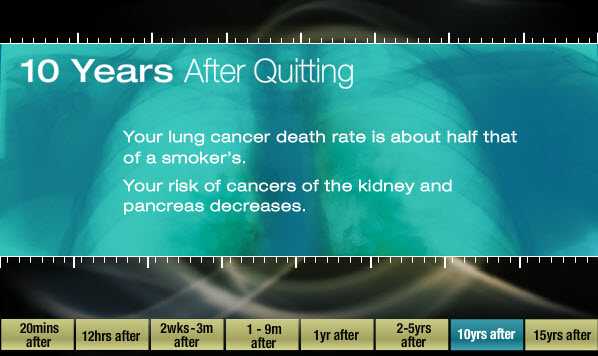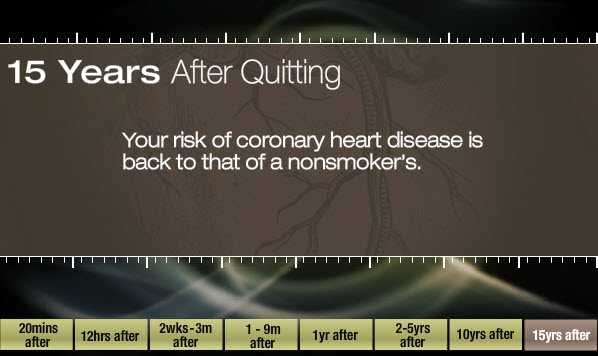Benefits of Quitting
- Quitting smoking at any age has benefits.1
- The sooner you quit, the sooner your body can begin to heal.1,2
- Tobacco smoke harms nonsmokers, too.1,3
- Quitting smoking is the single best way to protect your family from secondhand smoke.4
Reduced Risk for Various Health Issues1,2
Some benefits of quitting smoking occur quickly; more occur over time. For example:
- Your risk for a heart attack drops sharply just 1 year after you quit smoking.
- After 2 to 5 years, your chance for stroke could fall to about the same as a nonsmoker's.
- Within 5 years of quitting, your chance of cancer of the mouth, throat, esophagus, and bladder is cut in half.
- Risks for other conditions—including ulcer, peripheral artery disease, and cancers of the larynx, lung, and cervix—are reduced after quitting.
- The risk of having a low birth weight baby drops to normal if you quit before pregnancy or during your first trimester.
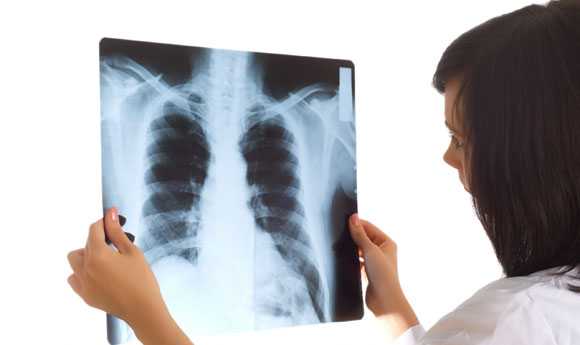
Other Benefits of Quitting
- Health benefits for people with diabetes who quit smoking begin immediately and include having better control over blood sugar levels.1
- If you quit smoking, you will breathe better and it will be easier to be active.1
- By not smoking, you help protect family, friends, and coworkers from health risks associated with breathing secondhand smoke. These include an increased risk for heart disease and lung cancer among adults. For babies and children, risks include respiratory infections, ear infections, and sudden infant death syndrome (SIDS).1,3

Quit Tips
Are you one of the more than 70% of smokers who want to quit? Then try following this advice.
1. Don’t smoke any cigarettes. Each cigarette you smoke damages your lungs, your blood vessels, and cells throughout your body. Even occasional smoking is harmful.
2. Write down why you want to quit. Do you want to—
- Be around for your loved ones?
- Have better health?
- Set a good example for your children?
- Protect your family from breathing other people’s smoke?
Really wanting to quit smoking is very important to how much success you will have in quitting.
3. Know that it will take commitment and effort to quit smoking. Nearly all smokers have some feelings of nicotine withdrawal when they try to quit. Nicotine is addictive.a Knowing this will help you deal with withdrawal symptoms that can occur, such as bad moods and really wanting to smoke.
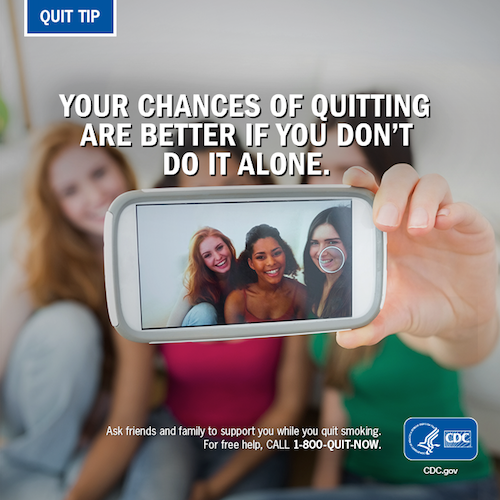
There are many ways smokers quit, including using nicotine replacement products (gum and patches) or FDA-approved, non-nicotine cessation medications. Some people do not experience any withdrawal symptoms. For most people, symptoms only last a few days to a couple of weeks.a Take quitting one day at a time, even one minute at a time—whatever you need to succeed.
4. Get help if you want it. Smokers can receive free resources and assistance to help them quit by calling the 1-800-QUIT-NOW quitline (1-800-784-8669) or by visiting CDC’s Tips From Former Smokers®. Your health care providers are also a good source for help and support.
Concerned about weight gain? It’s a common concern, but not everyone gains weight when they stop smoking.b Learn ways to help you control your weight as you quit smoking.
5. Remember this good news! More than half of all adult smokers have quit, and you can, too.c Millions of people have learned to face life without a cigarette. Quitting smoking is the single most important step you can take to protect your health and the health of your family.
Sources:
a. National Cancer Institute. How To Handle Withdrawal Symptoms and Triggers When You Decide To Quit Smoking. October 2010 [accessed 2013 June 5].
b. National Institutes of Health. You Can Control Your Weight as You Quit Smoking. February 2010 [accessed 2013 June 5].
c. Centers for Disease Control and Prevention. Quitting Smoking Among Adults—United States, 2001–2010. Morbidity and Mortality Weekly Report [serial online] 2011;60(44):1513–9 [accessed 2013 June 5].
Quit Smoking Resources
Government Resources
-
Tips From Former Smokers®
This CDC campaign Web site lets you view the ads, learn more about the people featured and their health conditions, and access quit-smoking resources. -
1-800-QUIT-NOW
A free, phone-based service with educational materials, coaches, a quit plan, and referrals to local resources to help you quit tobacco use. -
1-855-DÉJELO-YA (1-855-335-3569)
A free, phone-based service to help Spanish speaking persons quit tobacco use. . -
BeTobaccoFree.gov
This HHS Web site provides one-stop access to tobacco-related information, including information on quitting tobacco use, from its various agencies. -
smokefree.gov
A Web site that provides free, accurate information and assistance to help you quit smoking and stay tobacco-free. -
smokefree.gov (en Español)
A Spanish-language Web site that provides free, accurate information and assistance to help you quit smoking and stay tobacco-free. -
SmokefreeWomen
A Web site that provides free, accurate information and assistance to help women quit smoking and stay tobacco-free. -
SfT (Smokefree Teen)
A Web site that provides free, accurate information and assistance to help teens quit smoking and stay tobacco-free. -
SmokefreeTXT
A mobile service that provides encouragement, advice, and tips to help young adults quit smoking. -
Smokefree Smartphone Apps
Smokefree smartphone applications that help you track your quit smoking progress, receive motivational reminders, and more. -
Quit Tobacco—Make Everyone Proud
A DoD-sponsored Web site for military personnel and their families. -
Help for Smokers and Other Tobacco Users
An easy-to-read guide to quitting tobacco use. -
Treating Tobacco Use and Dependence: 2008 Update—Overview
Consumer materials to help tobacco users become tobacco-free. -
FDA 101: Smoking Cessation Products
Identifies FDA-approved products that can help you quit smoking. -
Harms of Smoking and Benefits of Quitting
A fact sheet from the National Cancer Institute that summarizes the harmful effects of smoking and short- and long-term benefits of quitting.
Other Resources
-
American Cancer Society
Guide to quitting smoking. -
American Heart Association
Information and support to help you quit smoking. -
American Lung Association
Resources to help smokers figure out their reasons for quitting and then take the big step of quitting for good.
References
- U.S. Department of Health and Human Services. A Report of the Surgeon General: How Tobacco Smoke Causes Disease: What It Means to You. Atlanta: U.S. Department of Health and Human Services, Centers for Disease Control and Prevention, National Center for Chronic Disease Prevention and Health Promotion, Office on Smoking and Health, 2010 [accessed 2013 June 5].
- U.S. Department of Health and Human Services. The Health Consequences of Smoking: What It Means to You. Atlanta: U.S. Department of Health and Human Services, Centers for Disease Control and Prevention, National Center for Chronic Disease Prevention and Health Promotion, Office on Smoking and Health, 2004 [accessed 2013 June 5].
- U.S. Department of Health and Human Services. The Health Consequences of Involuntary Exposure to Tobacco Smoke: A Report of the Surgeon General: Secondhand Smoke: What It Means To You. Atlanta: U.S. Department of Health and Human Services, Centers for Disease Control and Prevention, National Center for Chronic Disease Prevention and Health Promotion, Office on Smoking and Health, 2006 [accessed 2013 June 5].
- U.S. Department of Health and Human Services. The Health Consequences of Involuntary Exposure to Tobacco Smoke: A Report of the Surgeon General: Highlights: How to Protect Yourself and Your Loved Ones from Secondhand Smoke. Atlanta: U.S. Department of Health and Human Services, Centers for Disease Control and Prevention, National Center for Chronic Disease Prevention and Health Promotion, Office on Smoking and Health, 2006 [accessed 2013 June 5].
- Page last reviewed: March 17, 2016
- Page last updated: June 30, 2017
- Content source:


 ShareCompartir
ShareCompartir

